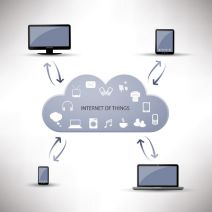Have any question?
Text or Call (954) 573-1300
Text or Call (954) 573-1300
 In the near future, there will be many new devices connecting to the Internet. Some will be useful, while others will be… not so much. Either way, the fact remains that, according to IDC, the Global Internet of Things (IoT) spending is expected to reach around $1.3 trillion by 2020. That’s a pretty huge number, and we’ll tell you why your organization needs to keep the IoT in mind when putting thought into your technology strategy.
In the near future, there will be many new devices connecting to the Internet. Some will be useful, while others will be… not so much. Either way, the fact remains that, according to IDC, the Global Internet of Things (IoT) spending is expected to reach around $1.3 trillion by 2020. That’s a pretty huge number, and we’ll tell you why your organization needs to keep the IoT in mind when putting thought into your technology strategy.
The Internet of Things is a loose term referring to a group of devices that are capable of connecting to the Internet. This can include your own devices, like your workstation, laptop, or smartphone, but its primary function is to group together all of the minor devices that are generally considered consumer devices; tech that wouldn’t normally have access to the Internet. Gartner's IT glossary defines the Internet of Things as:
[...] the network of physical objects that contain embedded technology to communicate and sense or interact with their internal states or the external environment.
In other words, these devices will be communicating with each other to help make life easier for their owners. The IoT has made a significant advancement in the business environment, and it’s not slowing down anytime soon. Gartner predicts that by the end of 2016, there will be over 6.4 billion devices connected to the Internet, and nearly 5.5 million new devices being added every day.
What kind of devices are falling under the IoT category? Everything from Smart Watches, digital cameras, fitness trackers, household appliances, security cameras, home and building automation, and even automobiles are starting to become more and more connected.
This impressive growth is a testament to how useful the IoT is for industries like manufacturing and transportation, but many of these devices will be consumer-based, and perhaps even in the possession of your employees.
With Internet of Things devices in your office, security is an immediate concern. You don’t want these Internet-connected devices accessing confidential data on your network, and because of their growing popularity, it becomes much more difficult to manage them. Furthermore, since these devices are connected to the Internet, you’ll have to worry about these devices being infected with viruses, malware, and other nasty threats. You don’t want them spreading the infection to your infrastructure, so it’s important that you don’t allow just any device to connect to your network.
To this end, your organization needs to have a comprehensive plan to handle IoT devices in the workplace, with no exceptions. Before allowing unknown devices to connect to your wireless network, be sure to have employees register their devices. Otherwise, you could be staring a data loss disaster right in the face, and be unaware of it. If your organization is having trouble working with Internet of Things devices, we’d be happy to help you come to terms with what they are and how they work.
For more information about the IoT and how you can keep your business safe, give L7 Solutions a call at (954) 573-1300.
If you didn’t know Windows can save a list of the text and images you copy, I feel for you—you’ve missed out on a simple trick that could’ve saved you a lot of time. But don’t worry, it’s easy to set up, and I’ll show you how.
Learn more about what L7 Solutions can do for your business.
L7 Solutions
7890 Peters Road Building G102,
Plantation, Florida 33324
Comments